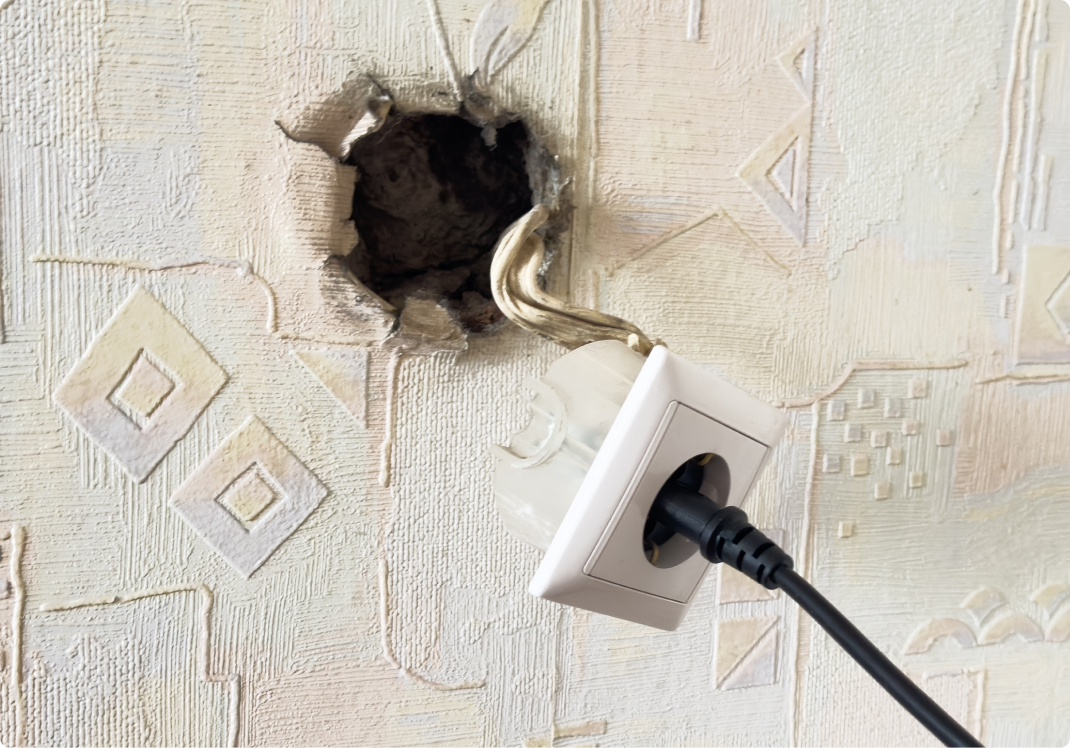How to Spot Electrical Problems in Your House

Having electricity makes life easier, but do you know how to spot electrical issues in your house? Here are some ways to identify common issues and what to do about them.


Having electricity makes life easier, but do you know how to spot electrical issues in your house? Here are some ways to identify common issues and what to do about them.
Electricity is something most of us take for granted. When you need it, you turn to the nearest switch or outlet, and there it is, ready to serve you 24/7. It illuminates our homes, keeps them cool or warm as needed, and powers all those appliances we rely on to keep our homes running smoothly everyday.
Yet that electric energy faithfully serving us is also a potential source of destruction. According to the National Fire Prevention Association, electrical malfunctions cause more than 46,700 mostly preventable house fires every year.
Before you get started with your electrical diagnosis, it’s important to make sure you’re staying safe and following basic electrical safety guidelines. Here are some safety tips every homeowner should follow before troubleshooting or diagnosing electrical issues:
Many electrical fire dangers are hidden within the walls of your house. However, if you know how to spot the warning signs of electrical problems in your home, you can make proactive—and less expensive—repairs that will help protect your home in the long run. Here are ten ways to identify common issues and what to do about them.
See how a protection plan can help with covered electrical line issues.

A new appliance might produce an unfamiliar odor upon first being installed. This could be due to the appliance's paint, finish or some other superficial issue. But should you detect an odd smell coming from an electrical outlet, unplug anything connected to it, and don’t use it again until a qualified electrician has checked it. Additionally, if your breaker panel or fuse box is emitting an odd odor, call an electrician immediately.
Arc faults occur when an electrical circuit veers off its intended path, often through a breach in the wiring. They are a frequent cause of electrical fires. However, arc faults are preventable through the installation of a device called an arc-fault circuit interrupter (AFCI). A professional electrician can install AFCIs. While they can be a bit pricey, the outlay is probably worth it, especially in older homes where the electrical wiring may have degraded.
If you’ve ever gone to a flea market and seen vendors selling things like extension cords, power strips and night lights at ridiculously low prices, beware. There's a strong possibility that they are counterfeit or not up to either industry or government standards and incredibly dangerous. Purchase your electrical products from reputable, established dealers, and always check to make sure the product bears a seal from the Underwriters Laboratory (UL).
If your light switches are warm to the touch or an outlet is sparking, call a professional electrician immediately to see if your wiring needs repairs or the fixture should be replaced.
Your outlets and switches should operate silently. If you hear any buzzing, cracking or sizzling sounds when you flip a switch or plug into an outlet, turn off the power to that fixture immediately and consult a professional electrician.
Flickering lights usually indicate a power surge. These power surges don't necessarily have to come from a catastrophic event — more than likely, your appliances are making demands on the electrical system that it cannot handle. These surges can take a toll on both your appliances and your electrical fixtures. If flickering lights are a frequent occurrence, it may be time to consider upgrading the wiring in your home.
If switches or outlets stop working or work only intermittently, it could be a sign of loose wiring — and another potential fire hazard. Loose outlets also create a potential for electrical shock. Even a partially exposed outlet could shock an unsuspecting individual who is plugging in or unplugging a cord.
Occasionally check the area around your ceiling fixtures for warmth that could indicate a lack of sufficient insulation. Also, exceeding recommended bulb wattages can cause overheating. Either issue poses a potential fire hazard. Consider switching to compact fluorescent light (CFL) or light-emitting diode (LED) bulbs as these don’t produce as much heat as incandescent bulbs.
Mice and rats love to chew on electrical wiring, and frayed or damaged wiring is a definite fire hazard. If you see any droppings or other signs of rodent activity in your attic, basement or around electrical fixtures, check all wiring in the area for signs of damage. If you're concerned about a rodent infestation, a pest control specialist can help you find out if you have an infestation and treat the problem.
Circuit breakers are designed to trip when a circuit is overloaded. Tripping prevents overheating and eliminates fire hazards. Occasional tripping probably indicates a simple overload, but if it occurs repeatedly, you need to call in an electrician and have them evaluate your entire electrical system.
All American Home Shield plans include Electrical Systems & Accessories coverage, featuring protection for essential components of a home’s electrical system–perfect for making sure electrical issues in your house don’t become major headaches. This coverage extends to the repair or replacement of electrical wiring, service panels, and breakers, as well as related elements like outlets, switches, and doorbells. Additionally, our plans cover ceiling fans, exhaust fans, and garage door openers–ensuring that both critical and commonly used electrical features are safeguarded.
It’s just one way that American Home Shield helps homeowners manage the costs associated with owning a house, providing protection against unexpected issues.
AHS assumes no responsibility, and specifically disclaims all liability, for your use of any and all information contained herein.
Have a plan for your home when things don't go according to plan
Shop Home WarrantiesDevelopment